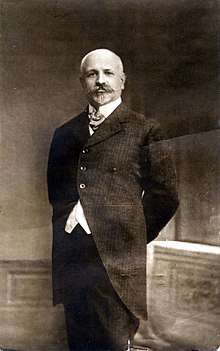Francesc Ferrer i Guàrdia
| Francesc Ferrer i Guàrdia | |
|---|---|
 | |
| Born |
10 January 1859 Alella, Catalonia, Spain |
| Died |
13 October 1909 (aged 50) Barcelona, Catalonia, Spain |
| Nationality | Spanish |
Francesc Ferrer i Guàrdia (Spanish: Francisco Ferrer Guardia; 10 January 1859 – 13 October 1909)[1] commonly known as Francisco Ferrer,[2] was a Spanish educator and advocate of free thinking from Catalonia.
Ferrer was the founder of the Escola Moderna (Escuela Moderna in Spanish), a non-compulsory primary and secondary school. Ferrer's pedagogical outlook — in large part — was inspired by the works of William Godwin and Jean-Jacques Rousseau, both of whom firmly rejected the idea of education brought about by means of compulsion.[3]
During Ferrer's life, la Escuela Moderna attracted international attention and prompted visits from George Bernard Shaw, H. G. Wells, Arthur Conan Doyle, and Leo Tolstoy. Tolstoy was so inspired by Ferrer's school that he started his own in Russia, which in 1921 served as inspiration for A. S. Neill's creation of today's Summerhill School in Suffolk, England.[4] Following the declaration of martial law in 1909 during the Tragic Week, he was declared guilty by a military tribunal.
His last confession was "Aim well, my friends, you are not responsible. I am innocent; long live la Escuela Moderna".
On 13 October 1909, Francisco Ferrer Guardia was shot dead at Montjuich Fortress.[5] He is buried there in the Montjuïc Cemetery.
Life
Ferrer was born in Alella (a small town near Barcelona) on January 10, 1859, to Roman Catholic parents who owned a vineyard.[6] He was sent to work at a Barcelona firm at the age of 15. The owner of the firm was an anti-cleric and is said to have had a great influence on Ferrer. A follower of Spanish republican leader Manuel Ruiz Zorrilla, Ferrer exiled with his wife and children in 1885. He lived in exile in Paris between 1886 and 1901.[7] Divorcing in 1899, he remarried a wealthy Parisian teacher shortly thereafter.
In 1901 he returned to Spain and opened the first Escuela Moderna (The Modern School) in Barcelona, starting with 12 girls and 18 boys.[8] in order to teach middle-class children (then) radical social values. In 1906 he was arrested on suspicion of involvement with the anarchist Mateu Morral's attack on King Alfonso XIII and released uncharged over a year later. His school failed and closed while he was incarcerated.
Early in the summer of 1908, after his release from jail, he wrote the story of the Modern School. The work was entitled The Origins and Ideals of the Modern School and was translated into English and published by the Knickerbocker Press in 1913.
After his death
Soon Benito Mussolini (back then a Socialist) spoke about his death in a public speech in Forlì (October 14, 1909).
In Anarchism and Other Essays, Emma Goldman called Ferrer a "rebel" and said that "his spirit would rise in just indignation against the iron régime of his country...".
Shortly after his execution, numerous supporters of Ferrer's ideas became much more vocal in the United States of America formed what were called Modern Schools, or Ferrer Schools, modeled after la Escuela Moderna. Emma Goldman also played a key role in creation of the Ferrer Association which attracted many prominent American thinkers like Upton Sinclair, Jack London, and Charles Edward Russell.[9]
The first and most notable Modern School was formed in New York City in 1911, and then later a community was founded around a school, known as the Ferrer Colony and Modern School.
Historian Carolyn Boyd labelled him as 'the high priest of anarchist education in Spain'.[10]
Works
References
- ↑ "Biografía de Francesc Ferrer i Guardia". Universidad de Huelva. Universidad de Huelva. Retrieved 28 August 2013.
- ↑ Baer 2015, p. 71; "Francisco Ferrer y Guardia came from a Catalan family that owned a vineyard. Francisco Ferrer, as he was commonly known, became radicalised in his youth and joined the Republican movement."
- ↑ Avrich 1980, pp. 3-35.
- ↑ Avrich 1980, pp. 172, 311, 322, 323, 341, 344, 362, 401.
- ↑ Goldman 1911; Avrich 2005, p. 191.
- ↑ Archer 2001, p. 3; Baer 2015, p. 71.
- ↑ Fidler 1985, p. 103.
- ↑ Fidler 1985, p. 103; Sprading 2007, p. 487; Baer 2015, p. 71.
- ↑ Avrich 1980, pp. 37-74.
- ↑ Laqua 2014, p. 468.
Bibliography
- Archer, William (2001) [1911]. The Life, Trial, and Death of Francisco Ferrer. Honolulu, HI: University Press of the Pacific. ISBN 0-89875-509-3.
- Avrich, Paul (1980). The Modern School Movement: Anarchism and Education in the United States. Princeton University Press. pp. 37–74.
|access-date=requires|url=(help) - Avrich, Paul (2005) [1995]. Anarchist Voices: An Oral History of Anarchism in America. Edinburg, Oakland-West Virginia: AK Press. ISBN 1-904859-27-5.
- Baer, James A. (2015), Anarchist Immigrants in Spain and Argentina, Urbana, Chicago and Springfield: University of Illinois Press, ISBN 978-0-252-03899-0
- Fidler, Geoffrey C. (1985). The Escuela Moderna Movement of Francisco Ferrer: "Por la Verdad y la Justicia". History of Education Quarterly. 25. Cambridge University Press. pp. 103–132. doi:10.2307/368893. JSTOR 368893.
- Goldman, Emma (1911) [1910]. "Chapter 6: Francisco Ferrer and the Modern School". Anarchism and Other Essays. New York & London: Mother Earth Publishing Association.
- Laqua, Daniel (2014). "Freethinkers, anarchists and Francisco Ferrer: the making of a transnational solidarity campaign". European Review of History. 21 (4): 467–484. doi:10.1080/13507486.2014.933185.
- Sprading, Charles T. (2007) [1913]. "XXIX. Francisco Ferrer". Liberty and the Great Libertarians. Auburn, AL: The Ludwig von Mises Institute.
External links
| Wikisource has original works written by or about: Francisco Ferrer Guardia |
| Wikimedia Commons has media related to Francesc Ferrer i Guàrdia. |
| Wikiquote has quotations related to: Francesc Ferrer i Guàrdia |
- Francisco Ferrer Collection MSS 248. Special Collections & Archives, UC San Diego Library.
- Francisco Ferrer Page at the Daily Bleed's Anarchist Encyclopedia
- Fundació Ferrer i Guàrdia
- Francisco Ferrer articles at the Kate Sharpley Library
- Francesc Ferrer i Guàrdia entry at the Anarchy Archives
- Die Erfindung des Globalen Protests
- Archer, William, The Life, Trial, and Death of Francisco Ferrer, New York: Moffat, Yard & Co.
